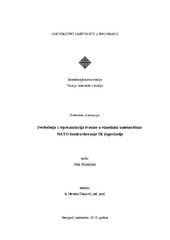Svedočenje i reprezentacija traume u vizuelnim umetnostima: NATO bombardovanje SR Jugoslavije
doktorska disertacija
Metapodaci
Prikaz svih podataka o zapisuDoktorand:
Mihaljinac, NinaFakultet:
Интердисциплинарне студије Универзитета уметностиDatum odbrane:
26-01-2017Mentor:
Daković, NevenaČlanovi komisije:
- Cvetić, Mariela
- Šuica, Nikola
- Đukić, Vesna
- Dragićević Šešić, Milena
Sažetak
Budući da NATO bombardovanje predstavlja prvi globalni/ virtuelni/ net/ tehno-rat,
prelomni momenat u političkoj i društvenoj istoriji u svetu i kod nas, disertacija pruža
doprinos boljem razumevanju brojnih savremenih fenomena koji se tiču međunarodnih vojnih
intervencija, kao i uloge umetnosti u procesu razvoja kulture sećanja globalne zajednice.
Putem analize sto šezdeset umetničkih radova - svedočanstava o NATO
bombardovanju, čiji autori imaju različite generacijske, rodne, nacionalne i političke identitete
– u disertaciji se ispituju mogućnosti izgradnje kritičke i participativne kulture sećanja i
kulturne politike, te načini strukturiranja umetničkog polja.
Potvrđena je hipoteza da određeni broj umetničkih radova reprodukuje rivalske
narative o bombardovanju, stvorene u dominantnim sklopovima sećanja u Jugoslaviji (tzv.
režimsko-patriotski i profitersko-izdajnički), kao i da većina radova ove narative prevazilaze i
kritikuju, negirajući simboličke društvene podele u Sr...biji. Dominantna strategija takvih,
kritičkih radova je strategija agitacije i oneobičavanja – razotkrivanja pozadine i istine o ratu,
dekonstrukcije propagandnih retorika sukobljenih strana (i NATO i Miloševićeve), te borbe
za mir. Druge strategije reagovanja na kolektivnu traumu (paralize, viktimizacije i otpužbe)
pokazuju diverzitet reprezentacija traume bombardovanja, međutim, ukupno uzev, umetnički
radovi na temu bombardovanja nisu asimilovani u kulturu sećanja, a njihova integracija je
neizvesna i otežana, što se moglo zaključiti iz pregleda postojećih projekata i javnih i civilnih
ustanova kulture u Srbiji.
Being that the NATO bombing represents the first global/ virtual/ net/ techno-war, a
turning point in the political and social history of the world and Yugoslavia, the doctoral
thesis provides a contribution to a better understanding of many contemporary phenomena
relating to international military interventions, and the role of art in the process of developing
a culture of remembrance of the global community.
Through the analysis of one hundred sixty artworks - testimonies of NATO bombing
of the Federal Republic of Yugoslavia, whose authors have different generational, gender,
ethnic and political identities - the thesis examines the ways of structuring of the artistic field,
and also the possibility of building a critical and participatory culture of remembrance and
cultural policy.
It has been shown that a small number of artworks reproduce rival narratives about the
bombing, created within dominant memory circuits in Yugoslavia (ie, “regime's patriotic” and
“profiteerin...g treacherous”), and that the vast majority of artworks go beyond and criticize
these conflicting narratives, negating the symbolic social division in Serbia. Their dominant
strategies are agitation and creating the effect of the uncanny, whose aim is to expose the
background and the truth about the war, to deconstruct the propaganda rhetoric of the
conflicting parties (both NATO and Milosevic's), and to struggle for peace. Other strategies of
reaction to collective trauma (paralysis, victimization and accusation) show the diversity of
representation of this cultural trauma, however, in general, it could be said that the artworks
on the topic of bombing have not been assimilated into the cultural memory, and that their
integration is uncertain and made difficult, which could be concluded from an overview of the
existing projects of both public and civil society cultural organisations in Serbia.

